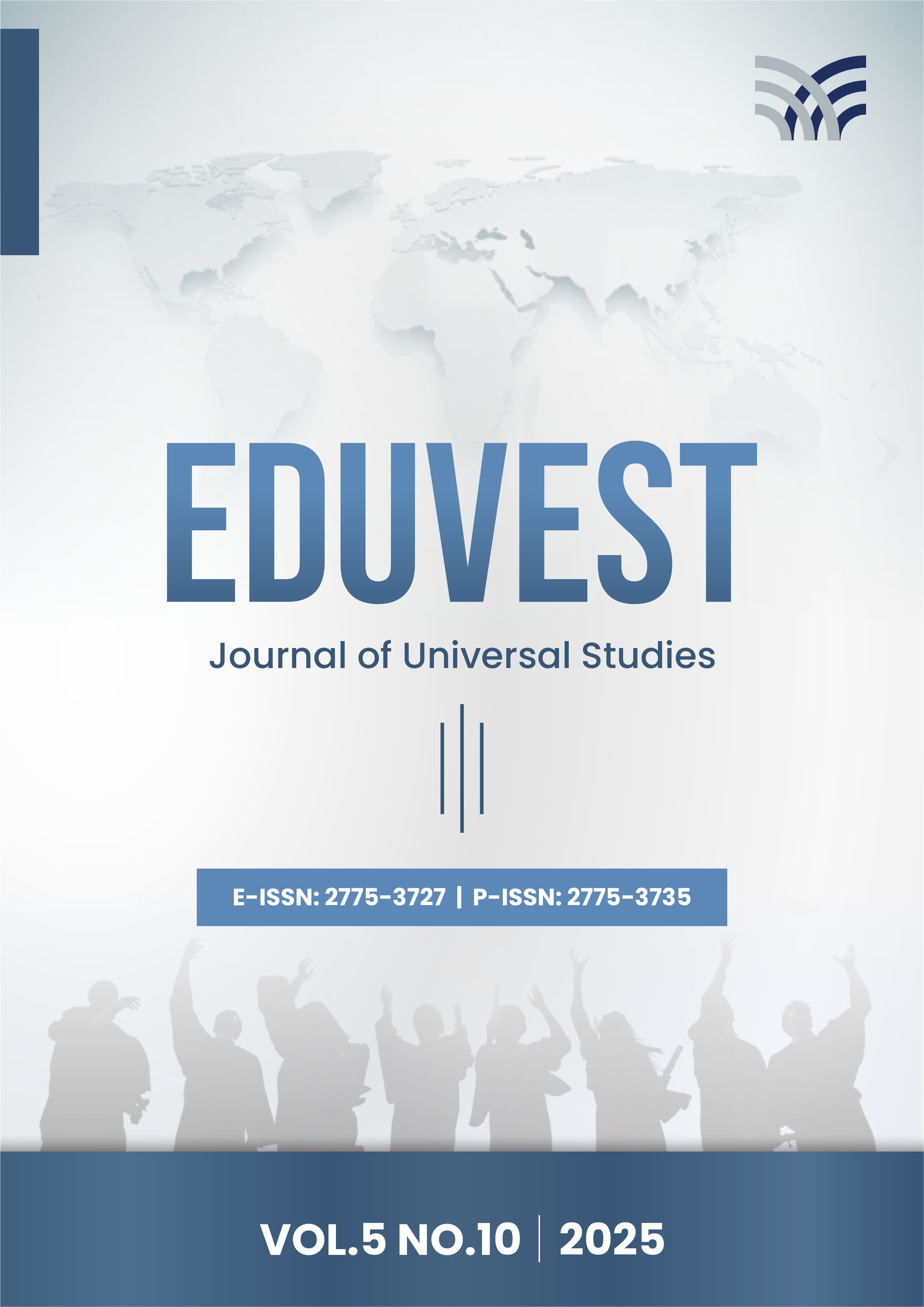Self-Esteem and Social Comparison as a Predictor of Body Image in Adolescent Girls
##semicolon##
https://doi.org/10.59188/eduvest.v5i10.51468##semicolon##
Self-Esteem##common.commaListSeparator## Social Comparison##common.commaListSeparator## Body Image##common.commaListSeparator## Adolescent GirlsAbstrakt
Body image concerns represent a significant mental health challenge among contemporary adolescent populations, particularly for girls navigating developmental transitions and sociocultural pressures related to physical appearance. The increasing prevalence of body dissatisfaction among youth has been associated with various psychological difficulties, including depression, anxiety, eating disorders, and diminished self-esteem, underscoring the urgency of understanding the factors that shape body image perceptions during this critical developmental period. This study aims to determine the extent to which self-esteem and social comparison can predict body image in adolescent girls. This research employed a quantitative approach using a correlational design. The subjects consisted of 100 female adolescents aged 16–21 years, located in Yogyakarta. The sampling technique used was cluster random sampling. Data were collected using questionnaires, namely the Rosenberg Self-Esteem Scale (RSES), the Iowa–Netherlands Comparison Orientation Measure (INCOM), and the Positive Body Image Adolescent Scale (PBIAS), all of which were adapted into Indonesian. Reliability testing used Cronbach’s Alpha, producing reliability coefficient values of 0.875, 0.857, and 0.950, respectively. Data analysis was performed using multiple linear regression with IBM SPSS version 26. The results showed that the hypothesis was accepted, with R = 0.642, R² = 0.412, and a significance value of 0.000 (<0.05). Therefore, self-esteem and social comparison have a positive and significant effect on body image in adolescent girls. This indicates that self-esteem and social comparison can predict body image in teenage girls by 41.2%, while other factors account for the remaining 58.8%.
##submission.citations##
Al-Sarraf, A. (2022). Skin lightening as an image enhancing phenomenon: investigating risks, motivations, and underlying psychological factors.
Branje, S., De Moor, E. L., Spitzer, J., & Becht, A. I. (2021). Dynamics of identity development in adolescence: A decade in review. Journal of Research on Adolescence, 31(4), 908–927.
Chae, H. (2022). Factors associated with body image perception of adolescents. Acta Psychologica, 227, 103620.
Dimitrova, R., Fernandes, D., Malik, S., Suryani, A., Musso, P., & Wiium, N. (2021). The 7Cs and developmental assets models of positive youth development in India, Indonesia and Pakistan. In Handbook of positive youth development: Advancing research, policy, and practice in global contexts (pp. 17–33). Springer.
Frederick, D. A., & Reynolds, T. A. (2022). The value of integrating evolutionary and sociocultural perspectives on body image. Archives of Sexual Behavior, 51(1), 57–66.
Ghozali, I. (2018). Aplikasi analisis multivariate dengan program IBM SPSS 25 (9th ed.). Badan Penerbit Universitas Diponegoro.
Hodge, J. D., & Cunningham, M. (2023). Academic self-esteem as a buffer between negative youth experiences and academic achievement in African American adolescents. Youth & Society, 55(5), 824–847.
Kaziga, R., Muchunguzi, C., Achen, D., & Kools, S. (2021). Beauty is skin deep; the self-perception of adolescents and young women in construction of body image within the Ankole society. International Journal of Environmental Research and Public Health, 18(15), 7840.
Kleemans, M., Daalmans, S., Carbaat, I., & Anschütz, D. (2018). Picture perfect: The direct effect of manipulated Instagram photos on body image in adolescent girls. Media Psychology, 21(1), 93–110. https://doi.org/10.1080/15213269.2016.1257392
Liu, H., Kvintova, J., & Vachova, L. (2025). Parents’ social comparisons and adolescent self-esteem: the mediating effect of upward social comparison and the moderating influence of optimism. Frontiers in Psychology, 16, 1473318.
Mahon, C., & Hevey, D. (2021). Processing body image on social media: Gender differences in adolescent boys’ and girls’ agency and active coping. Frontiers in Psychology, 12, 626763.
Marlinda, D., Sutatminingsih, R., & Daulay, D. A. (2022). Pengaruh perbandingan sosial terhadap citra tubuh pada remaja akhir putri pengguna Instagram. GUIDENA: Jurnal Ilmu Pendidikan, Psikologi, Bimbingan dan Konseling, 12(2). https://doi.org/10.24127/gdn.v12i2.5505
Merino, M., Tornero-Aguilera, J. F., Rubio-Zarapuz, A., Villanueva-Tobaldo, C. V., Martín-Rodríguez, A., & Clemente-Suárez, V. J. (2024). Body perceptions and psychological well-being: a review of the impact of social media and physical measurements on self-esteem and mental health with a focus on body image satisfaction and its relationship with cultural and gender factors. Healthcare, 12(14), 1396.
Moscu, G. (2024). Exploring the Relationship between Resilience (Personal Strength), Emotional Stability, Emotional Self-Control, Attachment, and Personal Fear of COVID-19. Bulletin of the Transilvania University of Braşov, Series VII: Social Sciences and Law, 17(1), 19–30.
Monteath, S., & McCabe, M. P. (1997). The influence of societal factors on female body image. The Journal of Social Psychology, 137(6), 708–727. https://doi.org/10.1080/00224549709595493
Pasaribu, M., Khairifa, F., Ali, R., Muis, A. A., & Ritonga, M. (2024). Youth character building through quality education in realizing golden Indonesia 2045. Journal of Ecohumanism, 3(4), 180–192.
Paulus, F. W., Ohmann, S., Möhler, E., Plener, P., & Popow, C. (2021). Emotional dysregulation in children and adolescents with psychiatric disorders. A narrative review. Frontiers in Psychiatry, 12, 628252.
Qomariyah, N., Romadhon, M. Q., Harto, K., & Suryana, E. (2025). The Development of Late Adolescents in Physical, Intellectual, Emotional, Social, Moral, and Religious Aspects and Its Implications for Islamic Education. Jurnal Pendidikan Islam, 15(1), 42–53.
Salomon, I., & Brown, C. S. (2025). Same gender typicality, risky technology use, and disordered eating among adolescents. Social Development, 34(1), e12783.
Scully, M., Swords, L., & Nixon, E. (2023). Social comparisons on social media: Online appearance-related activity and body dissatisfaction in adolescent girls. Irish Journal of Psychological Medicine, 40(1), 31–42.
Setiawan, A. S., Budiarto, A., & Indriyanti, R. (2023). Eating behavior of adolescent girls in countries with a high prevalence of stunting under five: a systematic review. Frontiers in Psychology, 14, 1228413.
Shobur, S. (2022). Insecure In Adolescent: Study Literature. International Journal Scientific and Professional, 1(3), 160–166.
Vani, M. F., Murray, R. M., & Sabiston, C. M. (2021). Body image and physical activity. Essentials of Exercise and Sport Psychology: An Open Access Textbook, 150–175.
##submission.downloads##
Publikované
##submission.howToCite##
Číslo
Sekcia
##submission.license##
##submission.copyrightStatement##
##submission.license.cc.by-sa4.footer##










